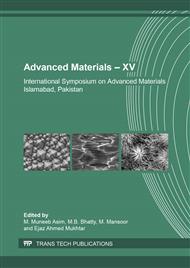p.45
p.53
p.61
p.71
p.79
p.86
p.91
p.100
p.111
Nickel Coated Carbon Nanomaterial for the Removal of Heavy and Toxic Metals (Cd, Cu) from Water and Wastewater
Abstract:
Heavy metals in water have always remained a point of concern for the environmental scientists due to their non biodegradability and toxicity. Adsorption and membrane filtration are the most widely studied and applied processes for the treatment of water. Activated carbons have frequently been used for the removal of heavy metals from water by the process of adsorption. With the development of nanotechnology, nanomaterials are used as the adsorbents in water treatment and have proved effective for the removal of heavy and toxic metals from water. nanocarbon materials, nanometal particles and polymer supported nanoparticles are widely used. A new adsorbent comprising of graphite coated with nanonickel particles was prepared, characterized and used for the removal of heavy and toxic metals from water. nanomaterial was characterized using ICP-AES, FTIR, XRD, and SEM. It was used for the removal of cadmium and copper from water. Kinetics and thermodynamics of adsorption of cadmium and copper on both the materials was investigated and compared. Adsorption isotherm of Langmuir, Freundlich and Dubinin-Radushkevich were also applied to the adsorption data for the adsorption and removal of cadmium and copper. Effect of pH was also studied and it was found that nanomaterial was very effective for the removal of Cd and Cu from acidic solutions. Effect of different acids at different concentration was studied and it was found that nanomaterial remained stable for adsorption while carbon alone deteriorated. Results indicate that developed nanomaterial is a very effective adsorbent for the removal of heavy and toxic metals from water and wastewater.
Info:
Periodical:
Pages:
79-85
Citation:
Online since:
September 2018
Authors:
Keywords:
Permissions:
Share:
Citation:


